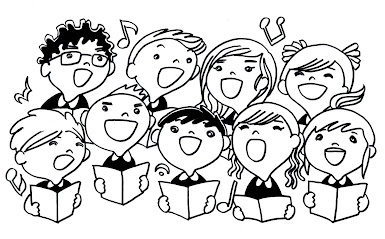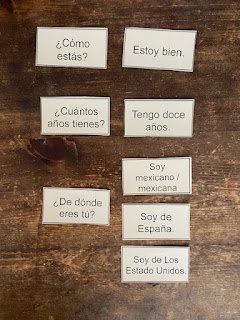As the weather gets colder and we move into the holiday season, many teachers look for fun and engaging ways to help their students improve Spanish. One of my favorite ways by far, for students both young and old to work on their Spanish in a fun way, is by listening to villancicos navideños (Christmas Carols).
Beyond the "catchy tune" that makes the lyrics stick in your head (I can still sing "Il Est Ne Le Divin Enfant" and Joe Dessin's "Aux Champs Elysses" from my high school French class 30 years later...) and the inevitable repetition of playing a fun song again and again (and hearing the musak version in stores while out and about), there are several reasons why actively listening to Christmas Carols (and other music) can help you learn Spanish.
1. Students learn more by using vocabulary in context rather than memorizing lists of words.
The more information you have about a word, the easier it will be to understand its use, use it yourself, and, finally memorize it. Brains love to learn new things by making associations or connections with information that is already known. Students will remember new information even easier if they have several facts or memories to connect the new one to.
When students listen to villancicos, they are learning Christmas vocabulary, but also words and phrases that are used during celebrations, winter, family, and culture. With context, not only do students learn a new word, but they also learn how this word is used and other words used with it. They can then use this new knowledge and apply it to conversations they have with classmates or other Spanish speaking members of their communities.
2. Students learn "real world" Spanish including idioms and slang.
Sometimes, as teachers, we tend to teach a very tame version of Spanish. It makes perfect sense! After all, we want our students to be respectful, have correct grammar, and present themselves well when they immerse themselves in a new language and culture.
However, many times, when our students travel or even just go to the local Mexican taqueria, they may not even understand what the native Spanish speakers are saying!
Why?
Because native speakers of all language often take liberties with that language!
Songs, even less traditional villancicos, may include "street Spanish" and more colloquial vocabulary. They may reference idioms or customary stories without explaining them completely.
3. Students learn Spanish in an active way.
Because students need to understand the words and phrases in order to understand the song, they tend to be more invested and more active in their learning. When trying to understand a song, it is not enough to just learn words in isolation...instead, they must understand the verb conjugations, the context, and the overall meaning of the song.
Additionally, instructors can make the learning even more active by providing activities that go along with the Christmas Carols.
Many teachers provide lyric fill-ins, where key vocabulary is left for the student to complete while listening to the song. This can even be scaffolded by having the infinitive version of the verb listed and the student must listen to the song to hear how it is conjugated.
Students can also complete activities related to the song. They can be as simple as a coloring sheet for more introductory levels of Spanish, or something more complex, like a crossword puzzle or word search, an essay prompt, or a "craftivity".
When students learn new vocabulary and grammar through Villancicos, and then actively apply that knowledge, it is more likely to "stick".
4. Listening to Christmas Carols improves pronunciation.
The fact of the matter is that it is extremely difficult to give students enough authentic input of their target language to become fluent. Every extra bit of "real world Spanish" that we can expose them to will improve their Spanish immensely. It is not enough to just read and write and speak with classmates. Students need to hear a variety of native speakers speaking (and singing!) Spanish in order to perfect their intonation, rhythm, and pronunciation. Christmas Carols are perfect for this!
Not only are they familiar and fun, but traditional carols often feature slower tempos and more traditional vocabulary. Many are extremely repetitive so students will hear the same words again and again. Students will be singing along (not realizing they are practicing their Spanish!) by the end of the song.
5. The songs' melody, rhythm, and rhyme helps students remember vocabulary and grammar.
Howstuffworks.com explains how attributes of Christmas Carols can help students memorize the Spanish language. The Method of Loci describes a way that the brain will learn new facts quicker if you associate them with known facts. For example, if your students listen to the traditional "Noche de Paz", they may be able to hum the familiar "Silent Night" tune to remember the words noche means night and paz means peace.
The rhythm inherent a song also helps students' minds to recall new vocabulary and phrases in two different ways: grouping and patterning. We know from experience that grouping items can help us memorize a series of numbers, such as a phone number. The same can be said for learning vocabulary and phrases in a target language! Additionally, rhythm is a pattern and orderly patterns are easier for our brains to remember because they are predictable and we can anticipate the next part of the pattern.
Finally, "acoustic encoding" is what helps us remember things that we hear. Since our brain naturally breaks down words by sounds, rhymes are much easier for us to process and remember.
6. Students learn better in a fun and relaxed atmosphere.
In this study presented in the 2016 European Conference for language learning, researchers found that learning through song improved students' vocabulary learning and retention. The brain is stimulated through music and song, and balances out the left (traditional classroom teaching) and right (music) brained learning of a language. However, one of the most significant findings of the study, in my opinion, was that students bonded and relaxed while listening to music, which enabled them to enjoy learning their target language and look forward to learning more in the future.
So what do you say? Have your students responded well to listening to Villancicos in class? Which are their favorites? Let me know in the comments below!
























